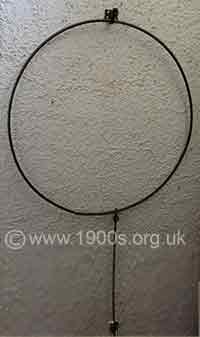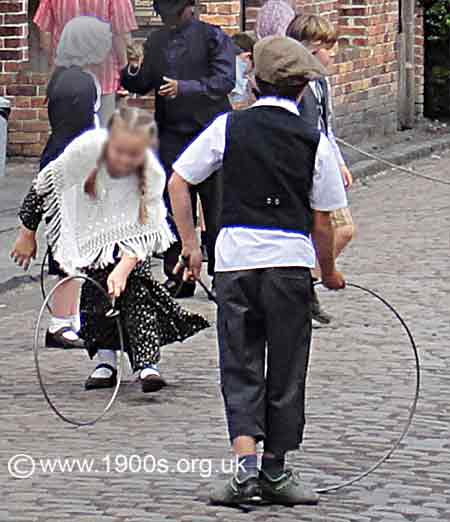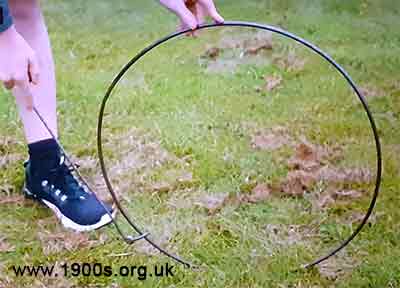
Hula hoops for children's fun and games, yesteryear and today
A hula hoop is a large hoop that can be twirled around the waist. Keeping it twirling requires vigorous hip movement, hence its name from the Hula Hawaiian dance form. In the past children also used hula hoops to chase along the ground, keeping the hoops going with their hands or a wooden stick. There used to be iron hoops, too, which could be chased along the ground using an attached iron rod. They are sometimes included in the general term of hula hoops, but were too heavy to have been used in dance or twirled round the waist. This page describes both types, explains how they were used in children's play and compares them with the hoops on sale today.
____
By the webmaster's mother (1906-2002), edited with further research by the webmaster and with contributions from others
Boys and girls both used to play with hoops in my childhood in the early 20th century, but they had different types.
Iron hoops for boys
The boys had iron hoops. They would start them rolling with their hands, then run along the street with them, using a rod loosely attached to the hoop.

Iron hoop hung on a wall* showing its rod attachment

Children playing with iron hoops at the Black Country Museum. [This modern photo shows girls as well as boys using the iron hoops, but note that my mother clearly states that iron hoops were only used by boys in her Edwardian childhood.]
How to run with old iron hoops
The reason that the old iron hoops fall over when children play with them today is that they try to keep the rods on top of the hoops as they run.
A demonstration by a modern expert showed me that the way that works is to keep the rods as near to the ground as possible and move the hoop by pushing it, as shown in the next photo.

Iron hoop being rolled by a modern expert with the rod kept close to the ground
The danger of metal hoops
These iron hoops were dangerous things if the boys didn't steer them carefully. This was because they were so heavy and invariably fast-moving. One went into my leg while I was walking home along my relatively quiet road. It really hurt and bled badly. I still have the scar.
Mary Wilkinson
Hoops for girls: hula hoops
For girls there were wooden hoops in various sizes. We just called them hoops but I understand that their full name was hula hoops.
The girls placed the hoops round their waists and rotated the lower parts of their bodies to keep the hoops going. The winner was the girl who kept her hoop going longest.
The girls would also use their hands or sticks to beat the hoops along the pavement, with whoever kept the hoops going furthest being the winner. There was also a technique to throw the hoop forward in such a way that it rolled back to you.
Today's hula hoops versus the old wooden hoops
The old iron hoops have completely gone out of fashion. Hula hoops are still on sale, but how often have you seen a child using them?
A significant difference between the old wooden hula hoops and those of today is their weight. Today's are too light-weight, and it is almost impossible to keep them going, twirling round the waist. In contrast the old, heavier wooden ones could be kept going for almost as long as energy permitted. Granted, the hoops of today do look more attractive and have the advantage of being brightly coloured. Some have flashing lights, but in my view they are unfit for purpose.
Of course, another significant reason why children don't play much with hoops today is the increase in traffic. Streets are no longer safe playgrounds for children and twirling hoops are not for inside homes.
Hoops may still be seen on beaches and they are certainly on sale in seaside shops, but I feel that children must tire of them very quickly.
* Photographed in the West Somerset Museum
If you can add anything to this page or provide a photo, I would be pleased if you would contact me.
Text and images are copyright
sources: early 20th century material
sources: ww2 home front and other material
contact
the webmaster/author/researcher/editor
privacy policy
















